The Electronic Musical Instruments Market is estimated to be valued at USD 757.1 million in 2025 and is projected to reach USD 1088.8 million by 2035, registering a compound annual growth rate (CAGR) of 3.7% over the forecast period.
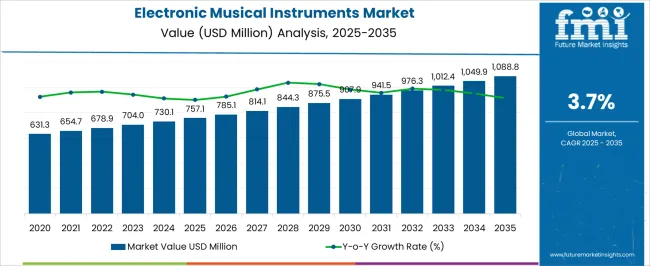
| Metric | Value |
|---|---|
| Electronic Musical Instruments Market Estimated Value in (2025 E) | USD 757.1 million |
| Electronic Musical Instruments Market Forecast Value in (2035 F) | USD 1088.8 million |
| Forecast CAGR (2025 to 2035) | 3.7% |
The electronic musical instruments market is undergoing dynamic transformation, driven by the rising integration of digital interfaces, enhanced sound modulation technologies, and growing demand for real-time performance adaptability. Advancements in hardware synthesis and software compatibility have allowed musicians, producers, and sound engineers to access highly customizable, performance-ready instruments across global music ecosystems.
Demand from live entertainment, content creation, and music education is further reinforcing investments in robust, scalable platforms that offer precision sound control and connectivity. Manufacturers are also focusing on intuitive UI design, hybrid digital-analog systems, and cross-platform compatibility to meet evolving consumer expectations.
The expansion of digital music culture through streaming and social media is fostering interest in electronic instrumentation among amateurs and professionals alike. With rising disposable income, increased festival culture, and home studio adoption, the market is expected to witness strong multi-regional growth driven by next-generation hardware and software convergence.
The market is segmented by Component and Product Type and region. By Component, the market is divided into Hardware and Software. In terms of Product Type, the market is classified into Public Address Equipment, String Musical Instrument, Digital Keyboards, Pianos, Drums & Percussion Instrument, DJ Gear, Music Synthesizer, and Others. Regionally, the market is classified into North America, Latin America, Western Europe, Eastern Europe, Balkan & Baltic Countries, Russia & Belarus, Central Asia, East Asia, South Asia & Pacific, and the Middle East & Africa.
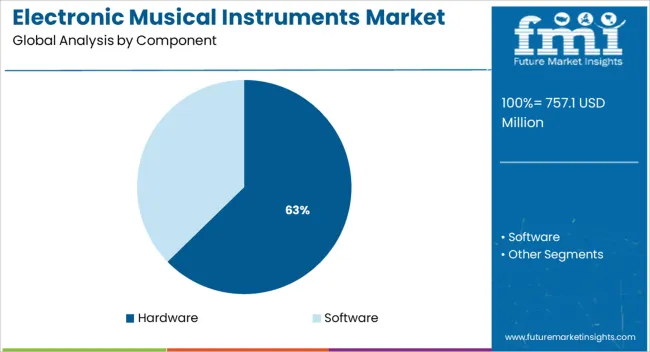
The hardware segment is expected to account for 62.7% of the total electronic musical instruments market revenue in 2025, making it the most dominant component. This leadership is attributed to the critical role hardware plays in real-time sound generation, signal processing, and performance output. Physical components such as synthesizers, electronic drums, amplifiers, and digital keyboards continue to be indispensable in both studio and stage settings.
Technological advances in chipsets, DSP engines, and sound banks have made modern hardware more powerful, modular, and responsive. Additionally, hardware products are being designed to support plug-and-play capabilities with minimal latency, which is vital for live performance accuracy.
The growth of music festivals, concerts, and touring events has increased demand for reliable, durable hardware that delivers consistent audio fidelity. As digital music production and live performance converge, hardware remains the backbone of electronic music systems, reinforcing its dominant revenue position.
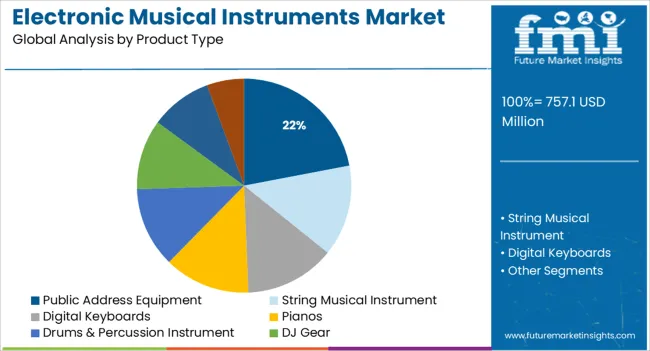
Public address equipment is projected to hold 22.0% of the electronic musical instruments market revenue in 2025, emerging as the leading product type. This is being driven by its widespread application in live music, DJ events, religious gatherings, and public speaking venues where high-volume, clear audio projection is critical.
Public address systems have evolved significantly with the inclusion of smart mixing consoles, wireless microphone integration, and Bluetooth-enabled connectivity, making them versatile for diverse performance environments. Their modular design supports scalability from small venues to large auditoriums, contributing to sustained demand across commercial and entertainment sectors.
Growth in outdoor music events, civic engagements, and educational institutions has further supported adoption. Additionally, continuous improvements in audio clarity, speaker durability, and feedback suppression have positioned public address equipment as a reliable solution for professional and semi-professional users alike, ensuring its continued market leadership.
The electronic musical instruments market players have lucrative potential over the projection period owing to new product innovations and technological advancements. The market is also influenced by the young generation's increased interest in music education and the usage of these instruments in the diversification of conventional and experimental music composition through the availability of high-quality instruments at affordable prices.
Additionally, urbanization and digitization, an increase in live music performances and concerts, and a growth in disposable income all benefit the electronic musical instruments market. Another critical reason propelling the growth of the electronic musical instruments market for electronic musical instruments is the expansion of the media and entertainment sector globally. Hence, the rising demand for music-related leisure activities is driving the growth of the electronic musical instruments market.
The electronic musical instruments market is also getting accelerated by the increased use of electronic musical instruments in genres of music like electronic and dance music. Another critical element driving the expansion of the electronic musical instruments market is the increased ability of consumers to spend a sizable amount on music concerts and live performances due to growing disposable income.
The demand for electrical musical instruments will be sustained by Western music's expanding acceptance and impact in emerging nations. The rise in the popularity of live music bands, music reality programs, and concerts is further anticipated to favor the electronic musical instruments market in the coming days.
Lengthier replacement cycles and the high cost of these instruments are anticipated to restrain electronic musical instrument market expansion. The lack of consumer interest in purchasing the devices is also a significant issue limiting electronic musical instrument market trends.
Nowadays, several laptop and smartphone manufacturers also support well-known music-producing applications. Hence, during the forecast period, the electronic musical instruments market is likely to face significant challenges from the rising popularity of these virtual musical instruments and music creation software.
Customizing musical instruments like electronic guitars and pianos is one of the emerging trends in the electronic musical instruments market. Thus, personalization and customization of electronic guitars have considerably contributed to the expansion of the musical instruments market by providing several opportunities.
Additionally, leading electronic musical instruments market players might see an opportunity in online sales in the upcoming years. Additionally, e-commerce has become necessary for players to grow their global sales and clientele in addition to shops.
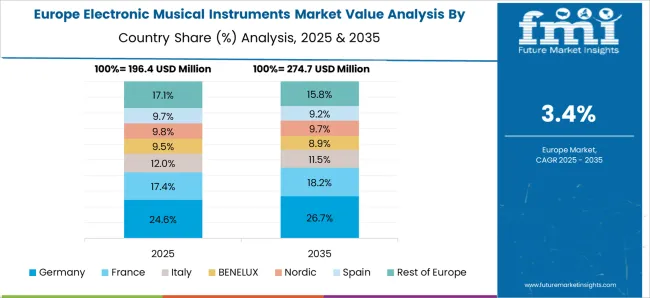
Owing to its relatively developed marketplaces and stable development rate over the projection period, Europe is expected to lead the worldwide electronic musical instruments market, holding a total share of 18%.
Most people in Europe spend a sizeable portion of their money on entertainment services, music festivals, and concerts. An increase in the number of significant players is supporting the expansion of the electronic musical instrument market.
Additionally, this region imports the most musical instruments, which significantly boosts the market's earnings. Europe is expected to have a substantial growth rate in the electronic musical instrument market in the subsequent years due to rising leisure spending and increased disposable income.
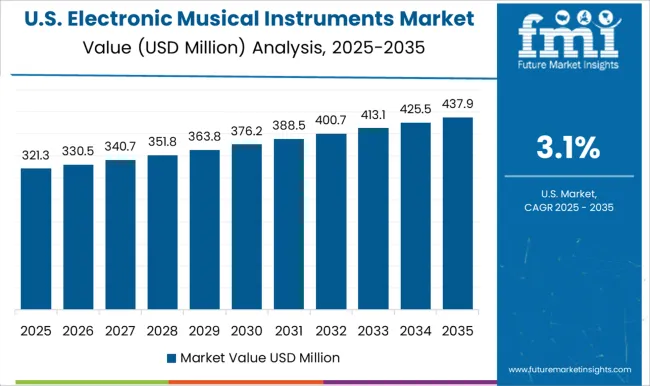
North America dominated the electronic musical instruments market, and this trend is anticipated to carry on during the forecast period due to the rapid technological development taking place in this region. Regarding market share, this region is expected to hold a 15.0% share.
The demand for electronic musical instruments will be sustained in the global market largely because of the expanding impact and popularity of music in emerging countries of North America. The primary market for electronic musical instruments in this region is the US.
Throughout the forecast period, North America's electronic musical instruments market will rise due to the introduction of novel items, rising demand for customized electronic musical instruments, and increased usage of online marketplaces for electronic musical instruments.
The market is fiercely competitive due to the existence of a massive magnitude of players. While there are a number of major worldwide companies, like Gibson Brands, Inc., Fender Musical Instruments Corporation, and Kawai Musical Instruments Manufacturing Co., they only represent a modest portion of the market. Several regional-level firms are also active in key geographical areas.
Aurzart, NIKKEI Asia, and Yamaha Make Waves are a few of the start-up businesses that are active in the electronic musical instruments market.
Example:
Aurzart is a renowned music retailer in India that offers a wide variety of musical equipment, including keyboard stands, digital pianos, and guitars.
Recent Developments
| Report Attribute | Details |
|---|---|
| Growth Rate | CAGR of 3.7% from 2025 to 2035 |
| Base Year for Estimation | 2024 |
| Historical Data | 2020 to 2024 |
| Forecast Period | 2025 to 2035 |
| Quantitative Units | Revenue in USD Billion and CAGR from 2025 to 2035 |
| Report Coverage | Revenue Forecast, Volume Forecast, Company Ranking, Competitive Landscape, Growth Factors, Trends and Pricing Analysis |
| Segments Covered | Product Type, Component, Region |
| Regions Covered | North America; Latin America; The Asia Pacific; Middle East and Africa; Europe |
| Key Countries Profiled | USA, Canada, Brazil, Argentina, Germany, UK, France, Spain, Italy, Nordics, BENELUX, Australia & New Zealand, China, India, ASEAN, GCC, South Africa |
| Key Companies Profiled | Gibson Brands, Inc.; Fender Musical Instruments Corporation; Kawai Musical Instruments Manufacturing ; Co. Ltd.; inMusic, Inc.; Pioneer Corporation; Steinway Musical Instruments Inc.; Yamaha Corporation; Roland Corporation; Audiotonix Limited; Casio Computer Co. Ltd |
| Customization | Available Upon Request |
The global electronic musical instruments market is estimated to be valued at USD 757.1 million in 2025.
The market size for the electronic musical instruments market is projected to reach USD 1,088.8 million by 2035.
The electronic musical instruments market is expected to grow at a 3.7% CAGR between 2025 and 2035.
The key product types in electronic musical instruments market are hardware and software.
In terms of product type, public address equipment segment to command 22.0% share in the electronic musical instruments market in 2025.






Our Research Products

The "Full Research Suite" delivers actionable market intel, deep dives on markets or technologies, so clients act faster, cut risk, and unlock growth.

The Leaderboard benchmarks and ranks top vendors, classifying them as Established Leaders, Leading Challengers, or Disruptors & Challengers.

Locates where complements amplify value and substitutes erode it, forecasting net impact by horizon

We deliver granular, decision-grade intel: market sizing, 5-year forecasts, pricing, adoption, usage, revenue, and operational KPIs—plus competitor tracking, regulation, and value chains—across 60 countries broadly.

Spot the shifts before they hit your P&L. We track inflection points, adoption curves, pricing moves, and ecosystem plays to show where demand is heading, why it is changing, and what to do next across high-growth markets and disruptive tech

Real-time reads of user behavior. We track shifting priorities, perceptions of today’s and next-gen services, and provider experience, then pace how fast tech moves from trial to adoption, blending buyer, consumer, and channel inputs with social signals (#WhySwitch, #UX).

Partner with our analyst team to build a custom report designed around your business priorities. From analysing market trends to assessing competitors or crafting bespoke datasets, we tailor insights to your needs.
Supplier Intelligence
Discovery & Profiling
Capacity & Footprint
Performance & Risk
Compliance & Governance
Commercial Readiness
Who Supplies Whom
Scorecards & Shortlists
Playbooks & Docs
Category Intelligence
Definition & Scope
Demand & Use Cases
Cost Drivers
Market Structure
Supply Chain Map
Trade & Policy
Operating Norms
Deliverables
Buyer Intelligence
Account Basics
Spend & Scope
Procurement Model
Vendor Requirements
Terms & Policies
Entry Strategy
Pain Points & Triggers
Outputs
Pricing Analysis
Benchmarks
Trends
Should-Cost
Indexation
Landed Cost
Commercial Terms
Deliverables
Brand Analysis
Positioning & Value Prop
Share & Presence
Customer Evidence
Go-to-Market
Digital & Reputation
Compliance & Trust
KPIs & Gaps
Outputs
Full Research Suite comprises of:
Market outlook & trends analysis
Interviews & case studies
Strategic recommendations
Vendor profiles & capabilities analysis
5-year forecasts
8 regions and 60+ country-level data splits
Market segment data splits
12 months of continuous data updates
DELIVERED AS:
PDF EXCEL ONLINE
Electronic Speed Controller (ESC) for Drones and UAVs Market Size and Share Forecast Outlook 2025 to 2035
Electronic Circulation Pump Market Size and Share Forecast Outlook 2025 to 2035
Electronic Lab Notebook (ELN) Market Size and Share Forecast Outlook 2025 to 2035
Electronic Control Unit in Automotive Systems Market Size and Share Forecast Outlook 2025 to 2035
Electronic Film Market Size and Share Forecast Outlook 2025 to 2035
Electronic Weighing Scale Market Size and Share Forecast Outlook 2025 to 2035
Electronic Packaging Adhesives Market Forecast and Outlook 2025 to 2035
Electronic Sealants Market Size and Share Forecast Outlook 2025 to 2035
Electronic Nasal Spray Devices Market Size and Share Forecast Outlook 2025 to 2035
Electronic Expansion Valves Market Size and Share Forecast Outlook 2025 to 2035
Electronics Adhesives Market Size and Share Forecast Outlook 2025 to 2035
Electronic Tactile Tester Market Size and Share Forecast Outlook 2025 to 2035
Electronic Trial Master File (eTMF) System Market Size and Share Forecast Outlook 2025 to 2035
Electronic Wipes Market Size and Share Forecast Outlook 2025 to 2035
Electronic Grade Trisilylamine Market Size and Share Forecast Outlook 2025 to 2035
Electronically Scanned Arrays System Market Size and Share Forecast Outlook 2025 to 2035
Electronics Retailing Market Size and Share Forecast Outlook 2025 to 2035
Electronic Dictionary Market Size and Share Forecast Outlook 2025 to 2035
Electronic Shelf Label Market Analysis - Size, Share, and Forecast Outlook 2025 to 2035
Electronics Films Market Size and Share Forecast Outlook 2025 to 2035

Thank you!
You will receive an email from our Business Development Manager. Please be sure to check your SPAM/JUNK folder too.
Chat With
MaRIA